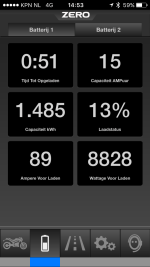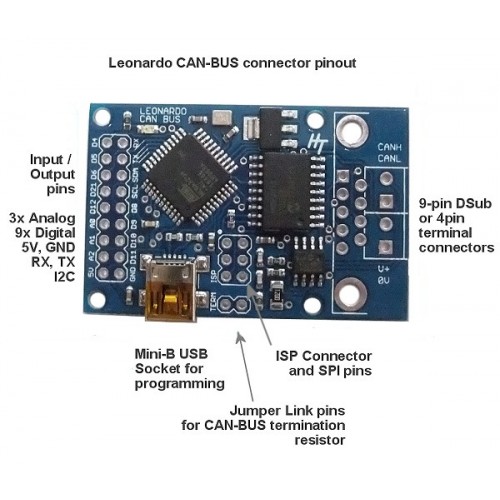// from rectifier : (requests for logins)
// 05014400 + ser nr + 00 00 from rectifier : HELLOOW where are you ! rectifier sends 05014400 and 6 bytes serial number and followed by 00 00 (login request)
// 0500xxyy + 1B + ser nr + 00 is send during normal voltage every second. xxyy is the last 2 bytes from the serial number
// after either of these send 05004804 every 5 seconds ! to keep logged in. rectifier does not send login requests so after 10 second the numbers stop until 05014400 is sent
// from rectifier : (status messages)
// 0501400C + status data : walkin and below 43 volts (error) and during walk-out (input voltage low)
// 05014010 + status data : walkin busy
// 05014004 + status data : normal voltage reached
// 05014008 + status data : current-limiting active
// send TO rectifier (act as controller)
// 05004804 + ser nr + 00 00 from controller : send 05004804 and 6 bytes ser number followed by 00 00
// 05FF4004 controller sends current and voltage limits (last 4 is 5 sec walk-in, for 60 second walk-in use 05FF4005)
// 05FF4005 controller sends current and voltage limits (last 5 is 60 sec walk-in, for 5 second walk-in use 05FF4004)
#include <mcp_can.h>
#include <mcp_can_dfs.h>
#include <SPI.h>
#include <LiquidCrystal.h>
word maxcurrent = 100; // set initial maxcurrent (divide by 10)
word outputvoltage = 5750; // set output voltage to 57.50 Volt (divide by 100)
word overvoltage = 5950; // set the overvoltage protection limit at 59.50 Volt (divide by 100)
bool longwalkin = HIGH; // HIGH is for 60 second walk-in, LOW is for 5 second walkin (watch the capitols !)
word currentstep = 100;
/* THIS IS THE MAIN PROGRAM FOR THE LEONARDO CANBUS BOARD
* DO NOT ALTER ANY CODE BELOW UNLESS YOU'RE A PROGRAMMER
*/
const int SPI_CS_PIN = 17; // set the input pin for the CANBUS receiver (on the leonardoboard = 17)
unsigned char len = 0; // this variable holds the length of the CANBUS message received
unsigned char serialnr[8]; // this variable holds the serialnumber of the Flatpack
int msgreceived; // this variable holds the number of messages received
int led = 23; // LED output pin for the leonardo CAN board= 23
int buttondown = 10;
int buttonup = 11;
MCP_CAN CAN(SPI_CS_PIN); // Set CS pin for CANBUS shield
//LiquidCrystal lcd(1, 3, 4, 5, 6, 7, 8); // LiquidCrystal(rs, rw, enable, d4, d5, d6, d7) or LiquidCrystal(rs, enable, d4, d5, d6, d7)
void setup() // Initialisation routine
{
pinMode(buttondown, INPUT); // Set pin 10 to input (pushbutton for down)
digitalWrite(buttondown, HIGH); // activate pull-up on A0
pinMode(buttonup, INPUT); // Set pin 11 to input (pushbutton for up)
digitalWrite(buttonup, HIGH); // activate pull-up on A0
pinMode(led, OUTPUT); // pin 23 is the output pin for the LEONARDO CANBUS board
digitalWrite(led, LOW); // turn the LED of
/* lcd.begin(16, 2); // splash screen on LCD
lcd.print("Flatpack Charger");
lcd.setCursor(0, 1);
lcd.print("Made by RHO");
*/
Serial.begin(115200); // Set the baudrate for the seial connection to the PC at 115200
START_INIT:
if(CAN_OK == CAN.begin(CAN_125KBPS)) // init can bus : baudrate = 125k !!
{
// lcd.setCursor(0,0);
// lcd.print("CAN BUS init OK!");
Serial.println("CAN BUS Shield init ok!");
}
else
{
// lcd.setCursor(0,0);
// lcd.print("CAN BUS init Fail");
// lcd.setCursor(0,1);
// lcd.print("Init CAN BUS again");
Serial.println("CAN BUS Shield init fail");
Serial.println("Init CAN BUS Shield again");
goto START_INIT;
}
// lcd.clear();
}
void loop() // main program (LOOP)
{
unsigned char buf[8] ;
if(CAN_MSGAVAIL == CAN.checkReceive()) // check if data coming
{
digitalWrite(led,HIGH); // turn the LED on
CAN.readMsgBuf(&len, buf); // read data, len: data length, buf: data buf
INT32U canId = CAN.getCanId(); // read the CAN Id
Serial.println(); // start on a new line
Serial.print("Received : 0"); // leading zero
Serial.print(canId,HEX); // output CAN Id to serial monitor
Serial.print("\t"); // send Tab
for(int i = 0; i<len; i++) // print the data
{
if( buf[i] < 0x10){ Serial.print("0");} Serial.print(buf[i],HEX); // send a leading zero if only one digit
Serial.print(" "); // space to seperate bytes
}
digitalWrite(led,LOW); // turn the LED off
if(canId==0x05014400) //this is the request from the Flatpack rectifier during walk-in (start-up) or normal operation when no log-in response has been received for a while
{
for(int i = 0; i<8; i++)
{
serialnr[i]=buf[i]; // transfer the message buffer to the serial number variable
}
Serial.print("\tSerial Number is : ");
for(int i = 0; i<6; i++) // print the data
{
if( serialnr[i] < 0x10){ Serial.print("0");} Serial.print(serialnr[i],HEX); // send a leading zero if only one digit
}
digitalWrite(led,HIGH);
CAN.sendMsgBuf(0x05004804, 1, 8, serialnr); //send message to log in (DO NOT ASSIGN AN ID use 00)
digitalWrite(led,LOW);
Serial.println();
Serial.print("TRANSMIT : 05004804");
Serial.print("\t");
for(int i = 0; i<len; i++) // print the data
{
if( serialnr[i] < 0x10){ Serial.print("0");} Serial.print(serialnr[i],HEX); // send a leading zero if only one digit
Serial.print(" "); // space to seperate bytes
}
Serial.print("\tLog in with SrNr : ");
for(int i = 0; i<6; i++) // print the data
{
if( serialnr[i] < 0x10){ Serial.print("0");} Serial.print(serialnr[i],HEX); // send a leading zero if only one digit
}
msgreceived++; // increase the variable "msgreceived"
unsigned char stmp7[8] = {lowByte(maxcurrent), highByte(maxcurrent), lowByte(outputvoltage), highByte(outputvoltage), lowByte(outputvoltage), highByte(outputvoltage), lowByte(overvoltage), highByte(overvoltage)}; // set rectifier to maxcurrent 57,0V (16 44) and OVP to 59.5V (17 3E) qnd long walk-in 4005 or short walk in 4004
if(longwalkin == HIGH)
{
digitalWrite(led,HIGH);
CAN.sendMsgBuf(0x05FF4005, 1, 8, stmp7); //(last 4 in header is for 5 sec walkin, 5 is for 60 second walkin)
digitalWrite(led,LOW);
Serial.println();
Serial.print("TRANSMIT : 05FF4005");
}
else
{
digitalWrite(led,HIGH);
CAN.sendMsgBuf(0x05FF4004, 1, 8, stmp7); //(last 4 in header is for 5 sec walkin, 5 is for 60 second walkin)
digitalWrite(led,LOW);
Serial.println();
Serial.print("TRANSMIT : 05FF4004");
}
Serial.print("\t");
for(int i = 0; i<len; i++) // print the data
{
if( stmp7[i] < 0x10){ Serial.print("0");} Serial.print(stmp7[i],HEX); // send a leading zero if only one digit
Serial.print(" "); // space to seperate bytes
}
// Serial.println();
// Serial.print("\t");
// for(int i = 0; i<len; i++) // print the data
// {
// if( stmp7[i] < 0x10){ Serial.print("0");} Serial.print(stmp7[i],HEX); // send a leading zero if only one digit
// Serial.print(" "); // space to seperate bytes
// }
Serial.print("\tImax set to : ");
Serial.print(0.1*(stmp7[0]+stmp7[1]*256));
Serial.print(" A\t");
Serial.print("Vout set to : ");
Serial.print(0.01*(stmp7[2]+stmp7[3]*256));
Serial.print(" V\t");
Serial.print("OVP set to : ");
Serial.print(0.01*(stmp7[6]+stmp7[7]*256));
Serial.print(" V\tWalkin : ");
if(longwalkin == HIGH)
{
Serial.print("60 seconds");
}
else
{
Serial.print("5 seconds");
}
}
else if(canId==(0x05000000+256*buf[5]+buf[6])) //if CANID = 0500xxyy where xxyy the last 2 digits of the serial nr
{
for(int i = 0;i<6; i++)
{
serialnr[i] = buf[i+1];
}
// unsigned char serialnr[8] = {buf[1], buf[2], buf[3], buf[4], buf[5], buf[6], 0x00, 0x00}; //this is the serial number of the unit which is covered in the request (unit announces its serial number)
Serial.print("\tSerial Number is : ");
for(int i = 0; i<6; i++) // print the data
{
if( serialnr[i] < 0x10){ Serial.print("0");} Serial.print(serialnr[i],HEX); // send a leading zero if only one digit
}
msgreceived++;
digitalWrite(led,HIGH);
CAN.sendMsgBuf(0x05004804, 1, 8, serialnr); //(last 4 in header is for 5 sec walkin, 5 is for 60 second walkin)
digitalWrite(led,LOW);
msgreceived=0;
Serial.println();
Serial.print("TRANSMIT : 05004804");
Serial.print("\t");
for(int i = 0; i<8; i++) // print the data
{
if( serialnr[i] < 0x10){ Serial.print("0");} Serial.print(serialnr[i],HEX); // send a leading zero if only one digit
Serial.print(" "); // space to seperate bytes
}
Serial.print("\tLog in with SrNr : ");
for(int i = 0; i<6; i++) // print the data
{
if( serialnr[i] < 0x10){ Serial.print("0");} Serial.print(serialnr[i],HEX); // send a leading zero if only one digit
}
unsigned char stmp7[8] = {lowByte(maxcurrent), highByte(maxcurrent), lowByte(outputvoltage), highByte(outputvoltage), lowByte(outputvoltage), highByte(outputvoltage), lowByte(overvoltage), highByte(overvoltage)}; // set rectifiers maxcurrent, outputvoltage and OVP and long walk-in 4005 or short walk in 4004
if(longwalkin == HIGH)
{
digitalWrite(led,HIGH);
CAN.sendMsgBuf(0x05FF4005, 1, 8, stmp7); //(last 4 in header is for 5 sec walkin, 5 is for 60 second walkin)
digitalWrite(led,LOW);
Serial.println();
Serial.print("TRANSMIT : 05FF4005");
}
else
{
digitalWrite(led,HIGH);
CAN.sendMsgBuf(0x05FF4004, 1, 8, stmp7); //(last 4 in header is for 5 sec walkin, 5 is for 60 second walkin)
digitalWrite(led,LOW);
Serial.println();
Serial.print("TRANSMIT : 05FF4004");
}
Serial.print("\t");
for(int i = 0; i<len; i++) // print the data
{
if( stmp7[i] < 0x10){ Serial.print("0");} Serial.print(stmp7[i],HEX); // send a leading zero if only one digit
Serial.print(" "); // space to seperate bytes
}
// Serial.println();
// Serial.print("\t");
// for(int i = 0; i<len; i++) // print the data
// {
// if( stmp7[i] < 0x10){ Serial.print("0");} Serial.print(stmp7[i],HEX); // send a leading zero if only one digit
// Serial.print(" "); // space to seperate bytes
// }
Serial.print("\tImax set to : ");
Serial.print(0.1*(stmp7[0]+stmp7[1]*256));
Serial.print(" A\t");
Serial.print("Vout set to : ");
Serial.print(0.01*(stmp7[2]+stmp7[3]*256));
Serial.print(" V\t");
Serial.print("OVP set to : ");
Serial.print(0.01*(stmp7[6]+stmp7[7]*256));
Serial.print(" V\tWalkin : ");
if(longwalkin == HIGH)
{
Serial.print("60 seconds");
}
else
{
Serial.print("5 seconds");
}
}
else if((canId==0x05014004)or(canId==0x05014008)or(canId==0x05014010)or(canId=0x0501400C)) // these are the status messages (05014004 is not current-limiting, 05014008 is current limiting 05014010 = busy with walkin, 0501400C in input voltage low)
{
Serial.print("\t");
Serial.print("Tin = ");
Serial.print(buf[0]); //first byte is temperature in (celcius)
Serial.print(" C\t");
Serial.print("Tout = ");
Serial.print(buf[7]); //last byte is temperature out (celcius)
Serial.print(" C\t");
Serial.print("Vin = ");
Serial.print(buf[5]); // sixth byte is input voltage in volts ac/dc
Serial.print(" V\t");
Serial.print("Iout = ");
Serial.print(buf[2]*256*0.1+buf[1]*0.1); // third (msb) and second byte are current in 0.1A (deciamp) calculated to show directly in Amps
Serial.print(" A\t");
Serial.print("Vout = ");
Serial.print(buf[4]*256*0.01+buf[3]*0.01); // fifth (msb) and fourth byte are voltage in 0.01V (centivolt) calculated to show directly in Volts dc
Serial.print(" V\t");
Serial.print("Pout = ");
Serial.print((2*buf[4]*256*0.01+2*buf[3]*0.01)*(buf[2]*256*0.1+buf[1]*0.1)); // Power is calculated from output voltage and current. Output is in Watts
Serial.print(" W\t");
msgreceived++; // record number of messages received
if(msgreceived>40)
{
msgreceived=0;
digitalWrite(led,HIGH);
CAN.sendMsgBuf(0x05004804, 1, 8, serialnr); //send message to log in every 40 messages (DO NOT USE ID NR, USE 00) this because during walk-in the 0500xxyy is not send and the rectifier "logs out" because of no received log-in messages from controller
digitalWrite(led,LOW);
Serial.println();
Serial.print("TRANSMIT : 05004804");
Serial.print("\t");
for(int i = 0; i<8; i++) // print the data
{
if( serialnr[i] < 0x10){ Serial.print("0");} Serial.print(serialnr[i],HEX); // send a leading zero if only one digit
Serial.print(" "); // space to seperate bytes
}
Serial.print("\tover 40 messages : Log in with SrNr : ");
for(int i = 0; i<6; i++) // print the data
{
if( serialnr[i] < 0x10){ Serial.print("0");} Serial.print(serialnr[i],HEX); // send a leading zero if only one digit
}
msgreceived++;
}
/* lcd.setCursor(0, 0); //show data on the LCD screen 0x050140yy 0xAA 0xBB 0xCC 0xDD 0xEE 0xFF 0xGG 0xHH
lcd.print("T=");
lcd.print(buf[0]); // 0xAA = Temperature in
lcd.print("/");
lcd.print(buf[7]); // 0xHH = Temperature out
lcd.print(" ");
lcd.setCursor(8,0);
lcd.print("I=");
lcd.print(buf[2]*256*0.1+buf[1]*0.1); // 0xBB = Current Low Byte, 0xCC = Current High byte. Current in deciAmps (*0.1 Amps)
lcd.print(" ");
lcd.setCursor(8,1);
lcd.print("Vo=");
lcd.print(buf[4]*256*0.01+buf[3]*0.01); // 0xDD = Voltage out Low Byte, oxEE = Voltage out High Byte. Voltgae in centivolts (*0.01 Volt)
lcd.print(" ");
lcd.setCursor(0,1);
lcd.print("Vi=");
lcd.print(256*buf[6]+buf[5]); // 0xFF = Voltage in Low byte, 0xGG = Voltage in High byte. Voltage in Volts (because voltage is below 255 Volts, high byte is always 0)
lcd.print(" ");
*/
if((digitalRead(buttonup)==0)) //read digital pin for button up and if it is low (pushbutton is pressed)
{
maxcurrent = maxcurrent + currentstep; // raise maxcurrent with 10 A
if(maxcurrent > 500) // to be able to lower the current with one button, if the maxcurrent > 50 the current is reset to 10
{
maxcurrent =100;
}
digitalWrite(led,HIGH);
CAN.sendMsgBuf(0x05004804, 1, 8, serialnr); // send message to log in (DO NOT ASSIGN AN ID) use 00
digitalWrite(led,LOW);
Serial.println();
Serial.print("TRANSMIT : 05004804");
Serial.print("\t");
for(int i = 0; i<8; i++) // print the data
{
if( serialnr[i] < 0x10){ Serial.print("0");} Serial.print(serialnr[i],HEX); // send a leading zero if only one digit
Serial.print(" "); // space to seperate bytes
}
Serial.print("\tLog in with SrNr : ");
for(int i = 0; i<6; i++) // print the data
{
if( serialnr[i] < 0x10){ Serial.print("0");} Serial.print(serialnr[i],HEX); // send a leading zero if only one digit
}
unsigned char stmp7[8] = {lowByte(maxcurrent), highByte(maxcurrent), lowByte(outputvoltage), highByte(outputvoltage), lowByte(outputvoltage), highByte(outputvoltage), lowByte(overvoltage), highByte(overvoltage)}; // set rectifiers maxcurrent, outputvoltage and OVP and long walk-in 4005 or short walk in 4004
if(longwalkin == HIGH)
{
digitalWrite(led,HIGH);
CAN.sendMsgBuf(0x05FF4005, 1, 8, stmp7); //(last 4 in header is for 5 sec walkin, 5 is for 60 second walkin)
digitalWrite(led,LOW);
Serial.println();
Serial.print("TRANSMIT : 05FF4005");
}
else
{
digitalWrite(led,HIGH);
CAN.sendMsgBuf(0x05FF4004, 1, 8, stmp7); //(last 4 in header is for 5 sec walkin, 5 is for 60 second walkin)
digitalWrite(led,LOW);
Serial.println();
Serial.print("TRANSMIT : 05FF4004");
}
Serial.print("\t");
for(int i = 0; i<len; i++) // print the data
{
if( stmp7[i] < 0x10){ Serial.print("0");} Serial.print(stmp7[i],HEX); // send a leading zero if only one digit
Serial.print(" "); // space to seperate bytes
}
Serial.print("\tButton pressed : Imax set to : ");
Serial.print(0.1*(stmp7[0]+stmp7[1]*256));
Serial.print(" A\t");
Serial.print("Vout set to : ");
Serial.print(0.01*(stmp7[2]+stmp7[3]*256));
Serial.print(" V\t");
Serial.print("OVP set to : ");
Serial.print(0.01*(stmp7[6]+stmp7[7]*256));
Serial.print(" V\tWalkin : ");
if(longwalkin == HIGH)
{
Serial.print("60 seconds");
}
else
{
Serial.print("5 seconds");
}
/* lcd.setCursor(0, 0); // announce chosen current on LCD
lcd.print("Current set to ");
lcd.setCursor(0, 1);
lcd.print(maxcurrent*0.1);
lcd.print(" Amp ");
*/ delay(1000);
}
}
else
{
// lcd.setCursor(0,0); // if the canId is unknown
// lcd.print(canId,HEX); // show the can Id and the message on the LCD
// lcd.setCursor(0,1);
// for(int i = 0; i<len; i++)
// {
// if( buf[i] < 0x10){ lcd.print("0");} lcd.print(buf[i],HEX); // send a leading zero if only one digit
// }
Serial.println("\tUNKNOWN COMMAND");
// delay(1000); // show the message for 1 second and then continue
}
}
}
/*********************************************************************************************************
END FILE
*********************************************************************************************************/





